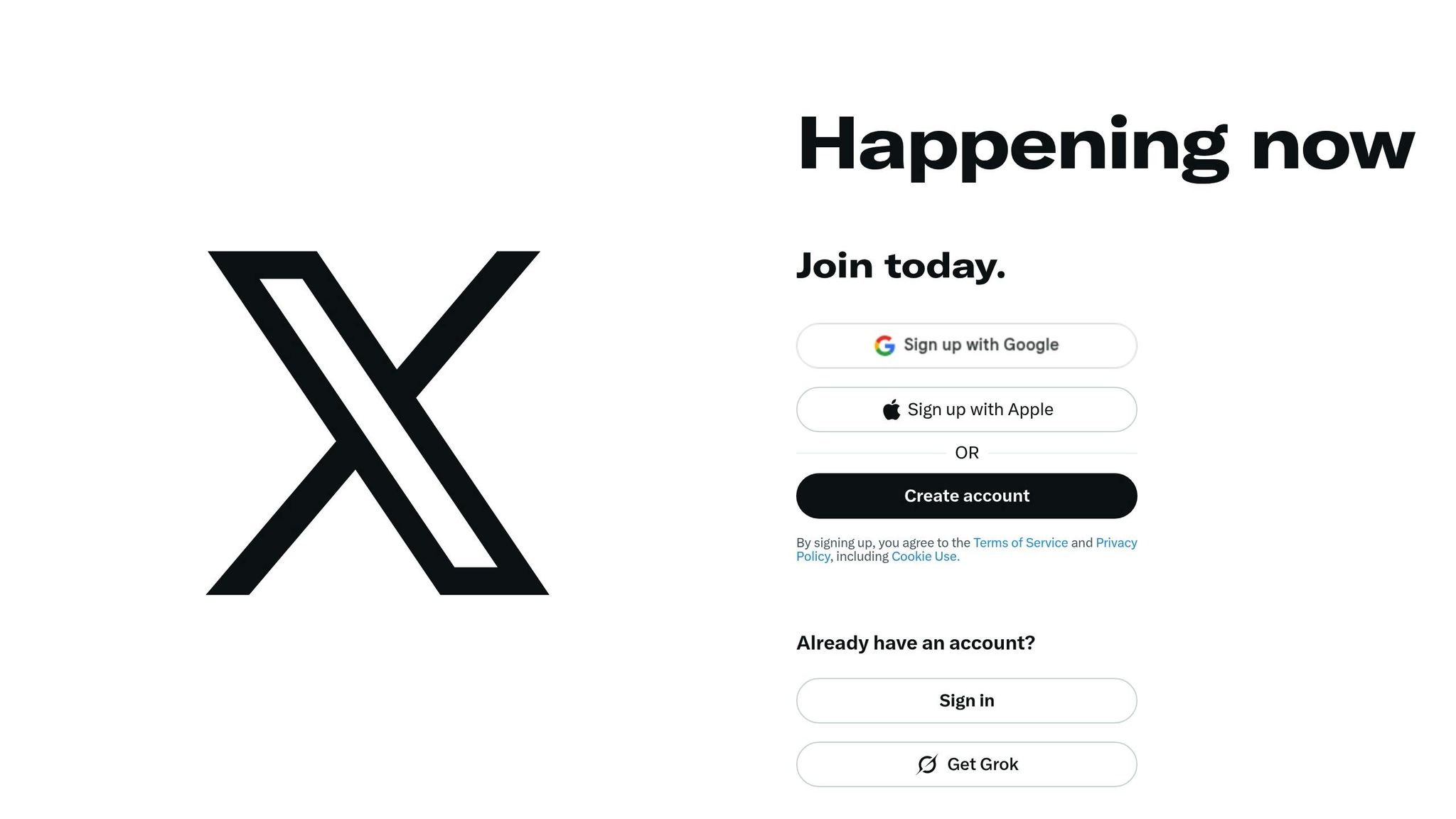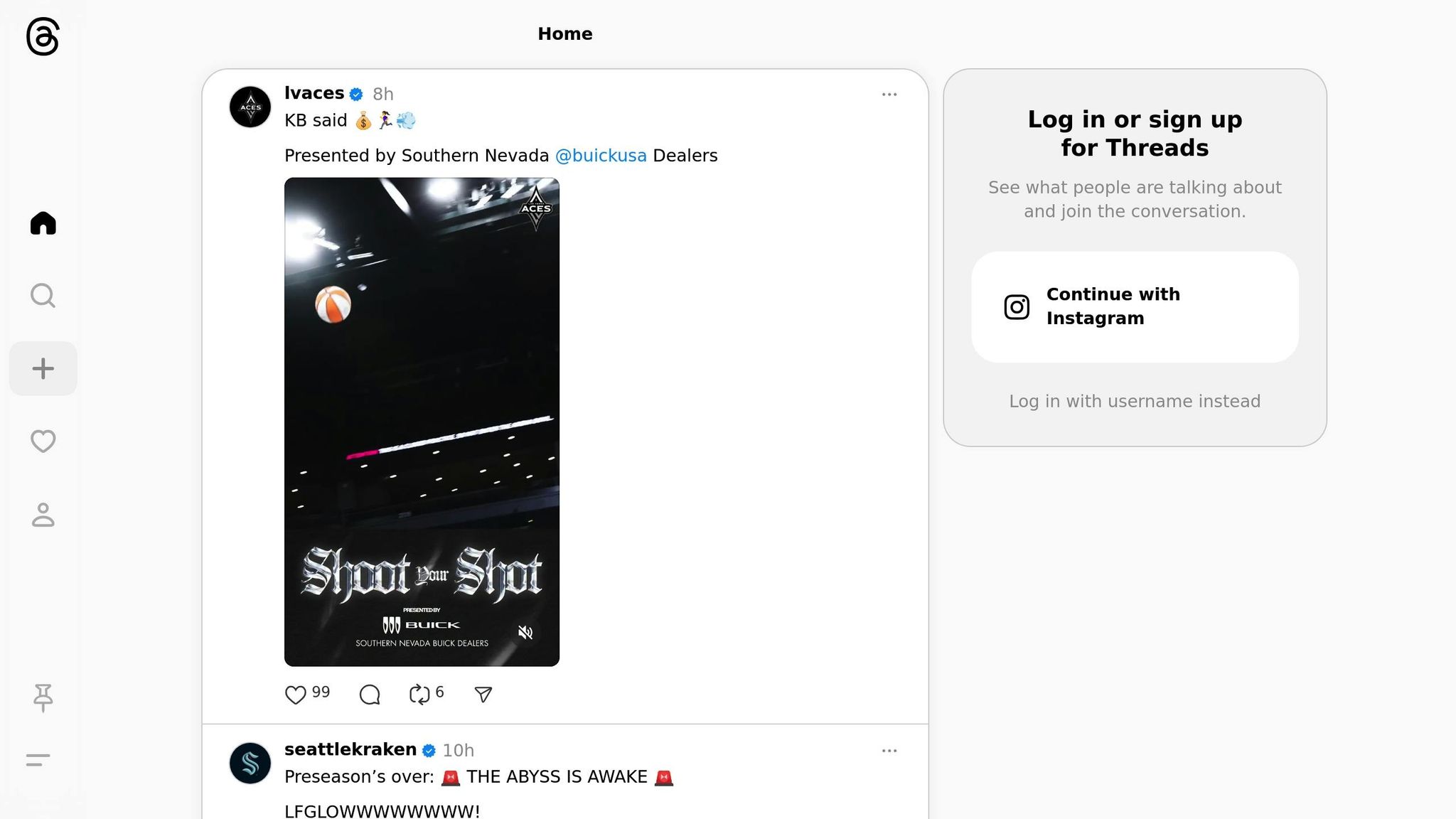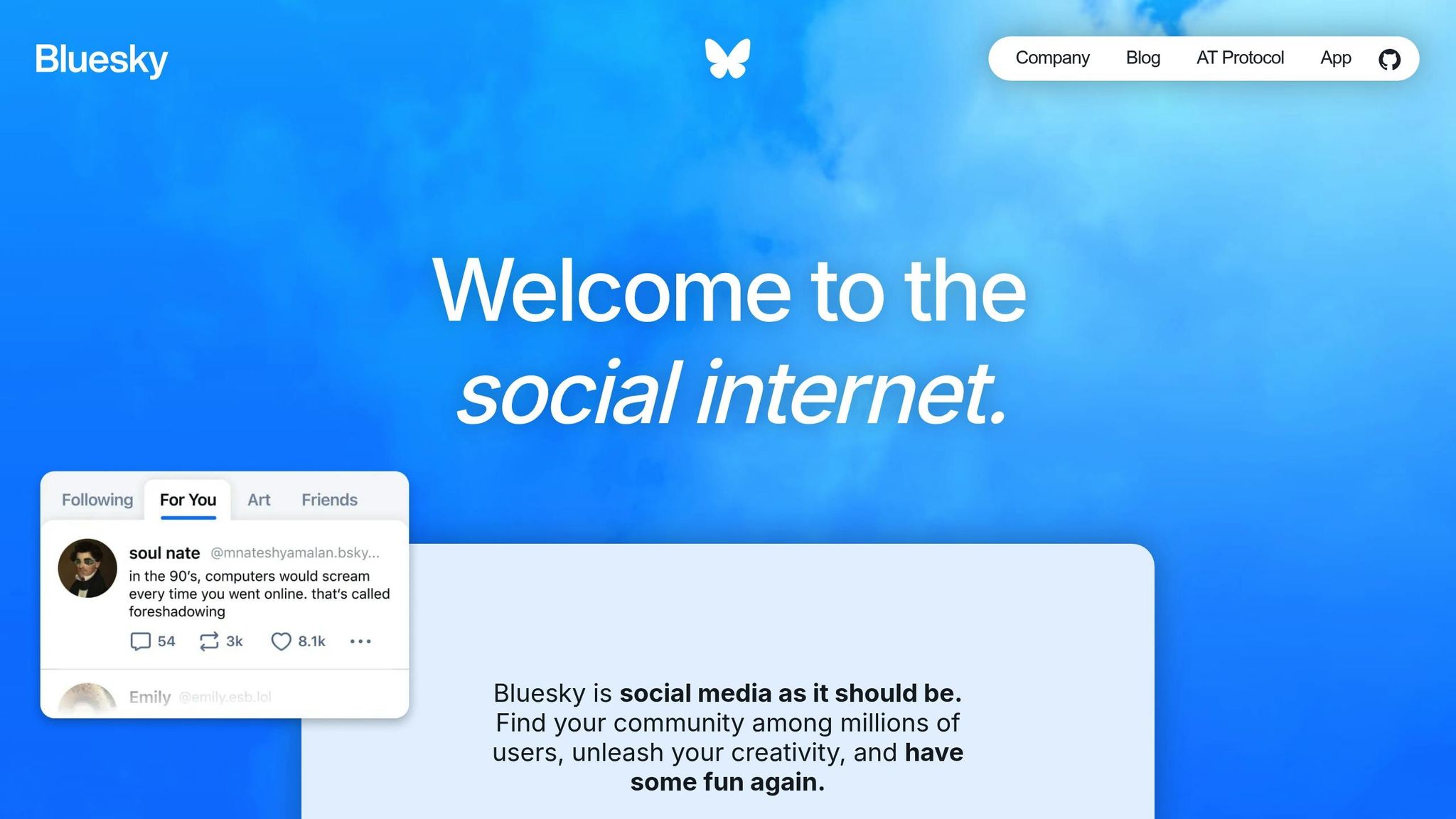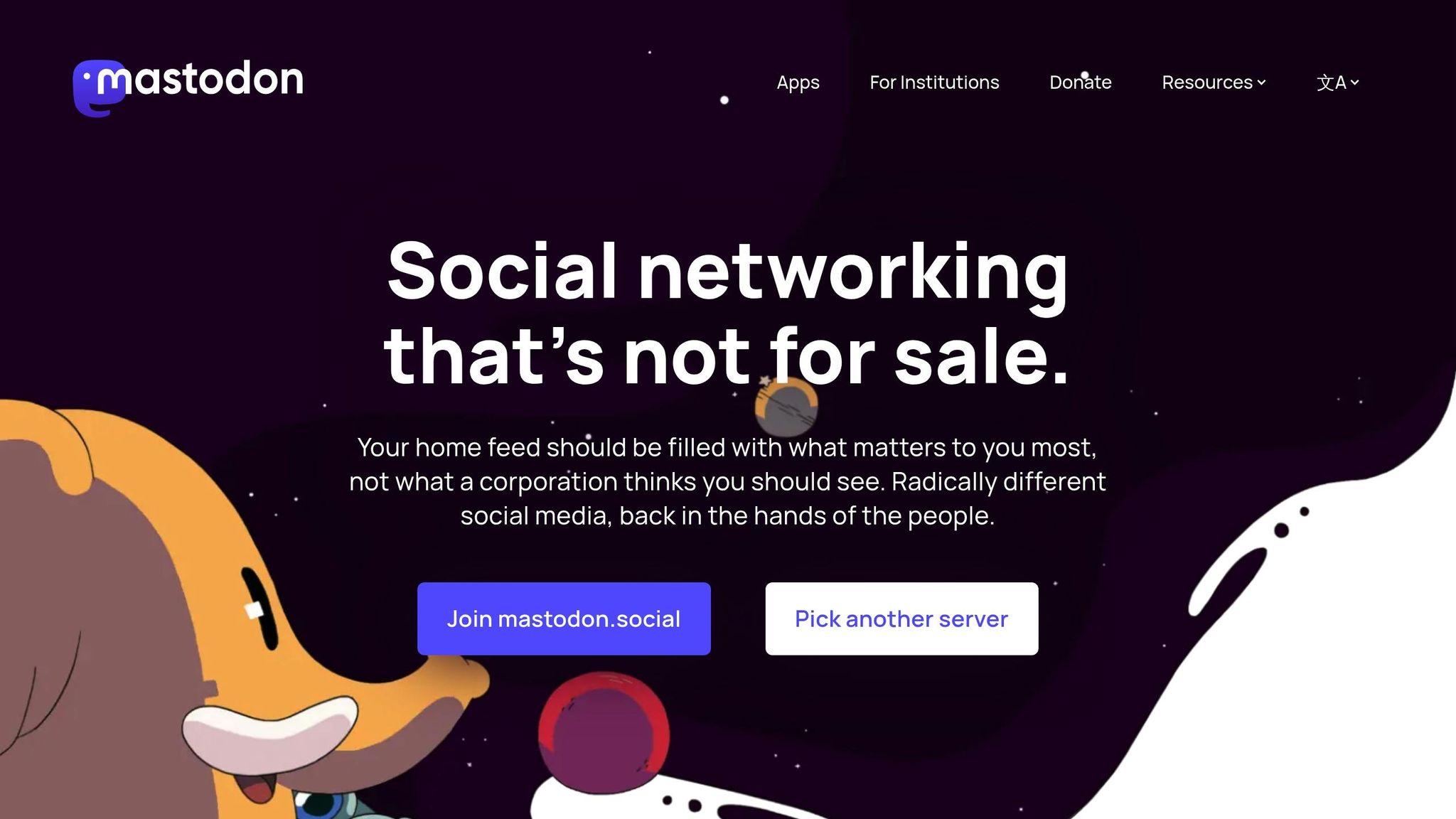Comparing Campaign Metrics Across Platforms
Not all social media platforms are created equal - and neither are their metrics. If you're running campaigns on X (formerly Twitter), Threads, Instagram, Bluesky, or Mastodon, it's critical to understand how each platform measures success. Here's the short version:
- X (Twitter): Prioritizes real-time engagement like retweets, replies, and trending topics. Timeliness is key.
- Threads: Focuses on text-based interactions with growing analytics tools, ideal for community-driven content.
- Instagram: Excels at visual storytelling with metrics like Story completion rates and Reel engagement.
- Bluesky: Smaller but highly engaged audience; chronological feeds reward well-timed posts.
- Mastodon: Decentralized and privacy-focused, with engagement relying on boosts, favorites, and replies.
Quick Comparison
| Platform | Key Metrics | Audience Behavior | Best For |
|---|---|---|---|
| X | Retweets, replies, impressions | Real-time, event-driven conversations | Trending, fast-paced campaigns |
| Threads | Text engagement, follower growth | Text-based community interactions | Building engagement with dialogue |
| Story completion, Reel plays | Visual content during leisure browsing | Visual storytelling | |
| Bluesky | Replies, reposts, likes | Smaller, engaged, tech-savvy audience | Niche, meaningful interactions |
| Mastodon | Boosts, favorites, replies | Privacy-conscious, niche communities | Focused, non-promotional content |
Key Takeaways
- Tailor content to each platform's strengths - what works on Instagram won't necessarily work on Bluesky.
- Smaller platforms like Mastodon and Bluesky may deliver higher engagement despite fewer users.
- Tools like TheBlue.social simplify cross-platform management and analytics.
Understanding these metrics isn't just helpful - it's the foundation for smarter, more effective campaigns.
Top Social Media Metrics to Analyze and How to Measure Them Effectively 📚
1. X (Twitter)

X is a fast-paced platform where real-time interactions can make or break a campaign. To succeed here, it's essential to understand how users engage and tailor your strategies accordingly.
Engagement Metrics
Engagement on X comes from actions like retweets, replies, likes, and impressions. These interactions reveal how your audience is responding to your content. Features like quote tweets add another layer by allowing users to share their thoughts, sparking deeper discussions around your campaign.
Audience Behavior
The audience on X is highly reactive, often shaped by current events and trending topics. To connect effectively, your messaging needs to be timely. Posting during peak activity periods can amplify your reach and foster more engagement.
Content Performance
Incorporating hashtags, creating native content, and using threads are proven ways to boost both visibility and interaction on X.
Analytics Features
X provides built-in analytics tools that deliver real-time insights into how your campaigns are performing. These tools let you track engagement trends and quickly adapt your strategy based on audience reactions.
For marketers juggling campaigns across platforms, TheBlue.social's cross-posting scheduler ensures your messaging stays consistent while optimizing timing for X. Up next, we’ll dive into how Threads stands out with its distinct engagement dynamics.
2. Threads

Threads has made waves, reaching 100 million users within just five days and hitting 115.1 million daily active users by June 2025 - a staggering 127.8% growth. These numbers highlight the growing importance of tracking platform-specific metrics[2].
Analytics Features
Threads provides built-in analytics through its Insights dashboard. For business accounts, this feature is available immediately, while personal accounts can access it after gaining 100 followers[1][2][4]. In July 2025, the platform upgraded its analytics tools, offering deeper insights and better cross-platform discovery features[3][5][6]. The revamped Insights dashboard now includes:
- Comprehensive content performance tracking
- Audience demographics and follower growth trends
- Cross-platform discovery insights
- "View sources" data to reveal how users find your content across platforms
These data points allow marketers to refine their strategies, ensuring their content resonates with the right audience.
For marketers looking to go beyond Threads, tools like TheBlue.social provide scheduling and analytics solutions that let you compare Threads' performance with other platforms. This helps tailor content strategies to match the unique engagement patterns of each platform. Meanwhile, Instagram's focus on visual content introduces a different set of metrics to consider.
3. Instagram
Instagram's focus on visuals creates a unique environment for tracking audience interaction. It provides marketers with detailed metrics that showcase how users engage with various content formats like feed posts, Stories, Reels, and IGTV.
Analytics Features
Instagram Insights, available for business and creator accounts, serves as the platform’s analytics hub. It offers performance data across different content types, giving marketers a well-rounded understanding of their visual content strategy.
The Insights dashboard is divided into key sections, including content performance, audience activity, and account reach. This structure allows marketers to easily connect engagement metrics with overall performance, helping them fine-tune their approach.
Engagement Metrics
Instagram’s engagement metrics are tailored to its visual nature. For instance, when users save a post, it signals that the content is particularly valuable. Similarly, tracking Story completion rates helps pinpoint where viewers lose interest, allowing marketers to refine multi-slide Stories for better retention.
Reels analytics, such as plays, accounts reached, and profile visits, are especially useful as Instagram continues to emphasize short-form video. These metrics provide a clear picture of how well Reels resonate with audiences.
Content Performance
Instagram’s algorithm rewards early engagement, which means marketers often focus on strategies that drive immediate interaction. Hashtags play a key role here, with the platform offering insights into which tags boost reach and engagement.
Different content formats perform differently on Instagram. For example, carousel posts often see better engagement than single images, and video content tends to benefit from the algorithm’s preferences. Understanding these patterns is essential for crafting a successful content strategy.
For those managing campaigns across multiple platforms, tools like TheBlue.social can help compare Instagram’s visual engagement metrics with performance on text-driven platforms. This ensures that strategies are tailored to each platform’s strengths. Up next, we’ll explore how newer platforms approach campaign metrics.
sbb-itb-a73accb
4. Bluesky

Bluesky takes a unique approach to campaign metrics, reflecting its decentralized nature and focus on user control and genuine engagement. With 35.2 million users and growing, it offers marketers a fresh but distinct audience, especially for those ready to embrace its specialized ecosystem.
Analytics Features
Bluesky's analytics are still in development, which presents both challenges and opportunities for marketers. To bridge this gap, third-party tools like TheBlue.social's Bluesky Analytics have become essential. These tools provide valuable insights into follower growth, engagement trends, and post performance - metrics that Bluesky’s native interface doesn’t yet fully support.
Engagement Metrics
On Bluesky, engagement revolves around likes, reposts, and replies. Its algorithm prioritizes chronological feeds and curated discovery over viral trends, creating a more community-driven environment. Replies hold particular importance, as they reflect the platform’s emphasis on meaningful interactions. Another standout feature is Bluesky's "starter packs", which allow marketers to measure community-building efforts by tracking how users discover content through curated recommendations.
Audience Behavior
Bluesky attracts users seeking alternatives to mainstream social platforms, often leading to higher engagement rates despite a smaller overall audience. The community is largely made up of early adopters and tech-savvy individuals who respond well to genuine, non-promotional content. Its decentralized structure gives users more control over their feeds, making organic content discovery harder but far more rewarding when successful. Campaigns that thrive on Bluesky usually focus on fostering community connections rather than relying solely on algorithms to amplify content. This approach highlights the importance of tailoring strategies for each platform.
Content Performance
Content behaves differently on Bluesky compared to algorithm-heavy platforms. Text-based posts that spark thoughtful discussions or cater to niche interests tend to perform well. The platform’s reply chains encourage extended conversations, allowing for in-depth storytelling and sustained engagement. Marketers who tap into these conversational threads often see better results than those sticking to isolated posts. Timing also plays a critical role - since Bluesky uses chronological feeds, posting during peak activity periods is key to maximizing visibility. Unlike platforms where content can resurface days later, Bluesky rewards well-timed, strategic posts.
For marketers, tools like TheBlue.social make it easier to compare Bluesky’s engagement metrics with broader campaign performance, helping integrate the platform into a comprehensive social media strategy.
5. Mastodon

After exploring Bluesky, let's dive into Mastodon and its unique decentralized setup.
Mastodon operates as a network of thousands of independent servers, called instances, that work together in a federated structure. This setup creates both challenges and opportunities for marketers, especially when it comes to tracking campaign metrics. Unlike centralized platforms, Mastodon’s design changes how data collection and audience targeting are approached.
Analytics Features
Mastodon's decentralized nature means there’s no single analytics dashboard. Instead, each instance provides only basic post statistics, like boosts (similar to retweets), favorites (akin to likes), and replies. For deeper insights, marketers often rely on third-party tools or manual tracking methods.
The platform’s focus on user privacy limits tracking capabilities. Marketers won’t find detailed demographic data, follower insights, or conversion tracking here - features that are common on centralized platforms. While this can make measuring traditional ROI more difficult, Mastodon attracts users who prioritize privacy and authentic interactions, presenting a different kind of marketing opportunity.
Engagement Metrics
On Mastodon, engagement revolves around three key metrics:
- Favorites: Comparable to likes, these indicate approval.
- Boosts: Amplify content beyond immediate followers, similar to retweets.
- Replies: Reflect meaningful, thoughtful engagement.
Since Mastodon uses a chronological timeline, content engagement peaks quickly after posting unless boosted by influential users.
Audience Behavior
Mastodon appeals to people looking for alternatives to mainstream social media, especially those concerned with data privacy and corporate influence. Its user base often includes tech-savvy individuals, open-source enthusiasts, and members of niche communities. For marketers, this means content that aligns with these values can achieve higher engagement.
Users typically join instances based on shared interests or values, creating tightly-knit micro-communities. For example, posting on a gaming-focused instance can reach a highly targeted audience that might not be as concentrated on a general-purpose server. This fragmentation requires marketers to understand the culture and preferences of individual instances rather than treating Mastodon as a single, unified platform.
Content Performance
Mastodon’s 500-character limit encourages long-form, detailed posts that foster meaningful discussions. Posts that spark thoughtful replies often continue to engage users over several days.
Images with detailed alt-text perform particularly well, reflecting the community’s strong emphasis on accessibility. While overtly promotional content may not resonate as it does on larger commercial platforms, educational or community-centered messaging tends to gain traction.
The federated structure adds another layer of unpredictability. A post might gain significant attention on one instance but remain unnoticed on others, making it challenging to measure cross-instance engagement consistently. This dynamic reinforces the importance of tailoring content to specific audiences within the platform’s diverse ecosystem.
Platform Strengths and Weaknesses
Understanding the strengths and weaknesses of each platform helps shape how resources are allocated. Each platform brings unique analytics, audience behaviors, and engagement patterns, presenting both opportunities and challenges. Here's a closer look at what each platform offers and where it falls short:
| Platform | Strengths | Weaknesses |
|---|---|---|
| X (Twitter) | Offers detailed analytics and demographic insights; great for real-time trending topics; encourages engagement through retweets and replies; precise ad targeting | Character limit limits detailed messaging; intense competition for visibility; algorithm changes affect organic reach unpredictably |
| Threads | Smooth integration with Instagram’s audience; familiar interface for Instagram users; excellent for visual content; growing user base with strong engagement potential | Lacks advanced analytics; still evolving as a newer platform; requires an Instagram account for access |
| Excels at visual storytelling with posts, Stories, and Reels; provides detailed audience insights; integrates shopping features well; high engagement on visuals | Demands consistent, high-quality visuals; favors video content over static images; limits link-sharing in posts | |
| Bluesky | Chronological timeline boosts content visibility; appeals to privacy-conscious users; growing community of early adopters; less crowded ad space | Limited analytics; smaller audience size; fewer third-party integrations; still developing its feature set |
| Mastodon | Strong privacy focus and engaged community; niche targeting through instance-based structure; no algorithmic filtering; encourages authentic conversations | No centralized analytics tools; fragmented audience across many instances; lacks demographic tracking; requires familiarity with federated systems |
Key Takeaways
- Analytics: X and Instagram lead with robust dashboards, while Threads is catching up. Bluesky and Mastodon often need third-party tools for deeper insights.
- Audience Behavior: Each platform attracts different types of users. X thrives on real-time updates, Instagram and Threads blend visual and conversational content, Bluesky rewards well-timed posts, and Mastodon focuses on niche, thoughtful interactions.
- Content Performance: Success depends on tailoring content to the platform. X prioritizes timeliness, Instagram excels with visually appealing posts, Threads balances visuals and conversations, Bluesky rewards strategic timing, and Mastodon values meaningful, authentic messaging.
Marketers also face varying levels of complexity when adapting to these platforms. X and Instagram provide extensive resources, guides, and best practices. Threads benefits from Instagram’s existing ecosystem while carving out its own space. Bluesky requires marketers to adapt to its emerging culture, and Mastodon demands a deeper understanding of its federated structure and instance-specific dynamics.
Conclusion
Social media is becoming more fragmented, with each platform offering distinct advantages for marketers aiming to maximize multi-channel campaign performance. To succeed, it's essential to understand how platforms differ and how their unique metrics can be used effectively.
X remains a top choice for real-time engagement and detailed analytics, boasting 650 million active users who can be reached quickly and efficiently[7]. Threads, with approximately 275 million monthly active users, is rapidly growing and plans to introduce advertising features in early 2025[7][9][10]. Instagram continues to dominate in visual storytelling, backed by a strong analytics framework. Bluesky is emerging as a promising option, with 36 million users and engagement levels nearly three times higher than X. Interestingly, about half of Bluesky's users have one or zero followers, offering early adopters a valuable opportunity to stand out[8][9]. Meanwhile, Mastodon, with its 15.5 million active users, fosters a privacy-conscious and highly engaged community, making it a great platform for authentic brand conversations[7]. These stats highlight the unique positioning of each platform and the importance of tailoring strategies to fit their strengths.
The secret to running successful cross-platform campaigns lies in playing to each platform's strengths rather than applying a one-size-fits-all strategy. For example, X thrives on real-time updates and customer service, while Instagram is perfect for visually compelling content. Threads fosters dynamic interactions with its growing user base, and Bluesky's chronological timeline and high engagement rates present exciting opportunities for brands. Mastodon, with its community-driven structure, allows for more focused and meaningful engagement. As discussed earlier, understanding how to interpret and use platform-specific metrics is the foundation for creating impactful campaigns.
To make managing these diverse platforms easier, tools like TheBlue.social allow marketers to handle cross-posting and analytics for X, Threads, Instagram, Bluesky, and Mastodon from one convenient dashboard. This streamlines operations and helps capitalize on each platform's unique engagement styles.
In today’s complex social media landscape, success means focusing your resources where your audience is most active and engaged. Prioritize two or three platforms that align closely with your brand’s goals, and keep a close eye on engagement metrics to refine your strategies as needed.
FAQs
::: faq
How can I adapt my content strategy to fit the unique engagement styles of different social media platforms?
To make your content strategy work effectively, focus on shaping your posts to fit the unique strengths and user habits of each platform. For instance, Instagram shines with visually appealing content like photos and short videos, while Threads and X (formerly Twitter) are perfect for short, conversational updates. Meanwhile, platforms like Bluesky and Mastodon lean toward community-focused, thoughtful discussions.
Adjust your tone, format, and posting frequency to match the vibe of each platform. Try out different approaches to see what clicks with your audience, and keep an eye on performance metrics to fine-tune your efforts. This way, you can boost engagement and ensure your content stays relevant and connects with users across various platforms. :::
::: faq
What are the main challenges and benefits of using decentralized platforms like Mastodon and Bluesky for marketing?
Decentralized platforms like Mastodon and Bluesky open up new opportunities for marketers, but they also bring their own set of challenges. One of the hurdles is the absence of centralized moderation. Without a single governing body to enforce content policies, it can be harder for brands to maintain consistent messaging and ensure compliance. Adding to this, user retention and engagement levels can vary significantly, meaning brands need to put in extra effort to grow and sustain their audience.
That said, these platforms also come with some clear advantages. They excel at niche targeting and encourage community-driven engagement, making it easier for brands to connect with specific audiences on a deeper level. Bluesky, for example, is particularly well-suited for strategies like thought leadership and decentralized identity, which can help brands build trust and nurture long-term relationships. By understanding the unique dynamics of these platforms, businesses can forge meaningful connections with highly engaged and loyal communities. :::
::: faq
How can TheBlue.social simplify managing campaigns and tracking performance across platforms?
TheBlue.social simplifies campaign management by letting users schedule and post content seamlessly across platforms like X, Threads, Instagram, Bluesky, and Mastodon - all from a single, user-friendly dashboard. This not only saves time but also ensures your messaging stays consistent across every channel.
It also offers analytics tools specifically designed for Bluesky, giving users the ability to track engagement, monitor follower growth, and refine their content strategies. These tools make managing campaigns smoother and help boost overall effectiveness. :::